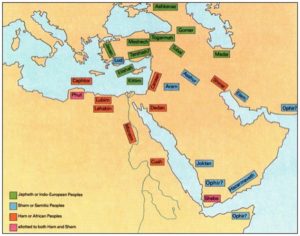Genealogies in Genesis

One of the fundamental issues in the dispute over a Biblical understanding of the age of the earth is how the genealogies in Genesis should be interpreted. Bishop Ussher’s chronology dated the creation of the heavens and earth in Genesis 1:1 to a very specific date in 4004 BCE. Editions of the King James translation of the Bible (KJV) began to disseminate his chronology in the 1650s. Then beginning in 1701, William Lloyd’s annotated edition of the KJV included Ussher’s chronology within marginal annotations and cross-references. The popular Scofield Reference Bible (1909/1917) also used it, which helped establish Ussher’s chronology as one of the key theological pillars of modern young earth creation belief.
Intriguingly, Ussher appears to have done his work in the midst of a dispute over biblical chronology in his time. According to The Oxford Handbook of the Bible in Modern England, c. 1530-1700, Robert Carey believed that errors in standard accounts of biblical history, relying on the apparent chronology of the Hebrew text, had provided the opportunity for some to attack the integrity and truth of the Bible. “He was critical of those who wanted to use apparent technical problems in biblical chronology to cast doubt on doctrinal certainties.” Cary and others believed that using the records of alternative sources could help resolve some of the apparent discrepancies. This was later referred to as scientific chronology, using the records of ancient history to make sense of the Bible.
Ussher’s conclusions seemed to bring a greater degree of certainty to a biblical chronology derived from the Hebrew Bible and orthodox readings of the text. His writings did this “at a time when chronology had become one of the most important determinants in a serious debate about the transmission and authority of the text of the Old Testament.” He was one of the first individuals to be fully aware of the variety of manuscript witnesses for biblical history “and the discrepancies in ancient testimony regarding the Old Testament.” His solution was to affirm the authority of the Hebrew Bible by his own extensive inquiries into the preservation and transmission of alternative textual witnesses, such as the Samaritan Pentateuch and the Septuagint.
So Ussher’s affirmation of the creation of the world at nightfall on Saturday, October 22, 4004 BCE, occurred within the context of disputes over the apparent chronology of the Hebrew text. At that time, certain individuals used these discrepancies to cast doubt on the transmission and authority of the text of the Old Testament. Today, holding to Ussher’s chronology is still seen as an integral part of affirming the authority of Scripture for many who hold to a young earth creation viewpoint.
Writing for the Institute for Creation Research, John Morris noted the association of Ussher’s chronology with the KJV in “Can the Ussher Chronology Be Trusted?” Morris clearly accepts Ussher’s dating for “all important historical events, beginning at creation and extending to the destruction of Jerusalem in a.d. 70.” He noted where an ICR colleague had modernized the language of Ussher’s original work, and hoped it would re-establish Ussher’s chronology as a standard research tool and restore for some, “their confidence in the Biblical record.”
In another ICR article, James Johnson used ‘simple math’ and the data provided in Genesis to conclude there was no good excuse for doubting the biblical chronological data. He rejected the “irrelevant” issue of whether Genesis genealogies were open (whether they skip generations and have gaps) or closed (the genealogies are complete). Upon completion of his own interpretation of Genesis timeframes, he said there was no good excuse for doubting the biblical chronological data as he presented it.
Yet biblical scholars beginning with William Henry Green in 1890 have continued to raise questions regarding the validity of Ussher’s chronology. Green’s article, “Primeval Chronology,” was published in the journal, Bibliotheca Sacra. He said the biblical genealogies in Genesis 5 and 11 were not intended for the construction of chronology.
It can scarcely be necessary to adduce proof to one who has even a superficial acquaintance with the genealogies of the Bible, that they are frequently abbreviated by the omission of unimportant names. In fact, abridgment is the general rule, induced by the indisposition of the sacred writers to encumber their pages with more names than were necessary for their immediate purpose. This is so constantly the case, and the reason for it so obvious, that the occurrence of it need create no surprise anywhere, and we are at liberty to suppose it whenever anything in the circumstances of the case favors that belief.
Several modern evangelical Old Testament scholars concur with Green. C. John Collins, as he discussed the biblical evidence for a historical Adam and Eve in Did Adam and Eve Really Exist?, noted that the genealogies in Genesis 4-5 do not claim to name every person in the line of descent from Adam, and therefore aren’t aimed at “providing detailed chronological information.” He added there was no way he knew of to assess what size gaps these genealogies allow. “It does not appear that they are intended to tell us what kind of time period they are describing.”
In his Genesis commentary from The Story of God Bible Commentary series, Tremper Longman said not all the genealogies in Genesis are of the same type or purpose. They are “ancient Near Eastern, not modern Western, genealogies.” The two main kinds of genealogies found in the Bible are linear and segmented. Linear genealogies go from father to one son (or ancestor), while segmented ones name a number of sons (or ancestors) from one father, as in Genesis 10. “Ancient genealogies are fluid.” They can skip generations. “They can change in order to reflect contemporary social and political realities.” According to R. R. Wilson, they are not normally created for historical purposes or intended to be historical records.
In the Bible, as well as in the ancient Near Eastern literature and in the anthropological material, genealogies seem to have been created for domestic, political-jural, and religious purposes, and historical information is preserved in the genealogies only incidentally.
The Eerdmans Bible Dictionary had a similar view on genealogies. It too said linear and segmented were the two major types of biblical genealogies. “Both types show fluidity among the middle names; names may be omitted or rearranged, or relationships changed.”
The Hebrews, like other ancient Near Eastern peoples, used genealogies to authenticate rights of inheritance (Num. 27:1–11), enhance the social position of outsiders (e.g., Caleb, son of Jephunneh the Kenizzite [Num. 32:12; Josh. 14:6; 15:13], becomes a son of Hezron—part of Judah; 1 Chr. 2:18), establish royal and cultic lineages (e.g., David, 1 Chr. 3; priests, 2 Chr. 31:16–19; Levites, Neh. 7:43–45; temple servants, vv. 46–56), and organize their social geography (Gen. 10). Usually only men are recorded.
Genesis 10 provides a list of the descendants of Noah. Many of the names in what is called the “Table of the Nations” have been identified with racial, geographical and political entities outside of the Bible. The following map, based on the Table of the Nations in Genesis 10, was taken from the New Bible Atlas:
 In his Genesis commentary, Bruce Waltke said genealogies serve several purposes in Genesis—purposes which depend in part upon the nature of the genealogy itself. Broad genealogies present only the first generations of descendants (the sons of Leah or the sons of Rachel in Genesis 35:23-26). Deep genealogies list sequential descendants, usually from two to ten. Linear genealogies display only depth (Genesis 4:17-18). Segmented genealogies display both depth and breadth (Genesis 10:1-29; cf. 11:27-29; 19:36-38). “The distinctions of broad, deep, linear and segmented genealogies help explain the various functions of genealogies.”
In his Genesis commentary, Bruce Waltke said genealogies serve several purposes in Genesis—purposes which depend in part upon the nature of the genealogy itself. Broad genealogies present only the first generations of descendants (the sons of Leah or the sons of Rachel in Genesis 35:23-26). Deep genealogies list sequential descendants, usually from two to ten. Linear genealogies display only depth (Genesis 4:17-18). Segmented genealogies display both depth and breadth (Genesis 10:1-29; cf. 11:27-29; 19:36-38). “The distinctions of broad, deep, linear and segmented genealogies help explain the various functions of genealogies.”
By tracing their lineage back to a common ancestor, broad and segmented genealogies show the existing relationships between kinship groups. Genealogies were used in tribal societies to express the rights and privileges within social relationships, rather than strict biological kinship. The Table of Nations noted above expressed the kinship and distinctions between Israel and the surrounding nations. “The segmented lists of tribes in Gen. 46:8-25 display both the unity of all Israel and the distinctness of its tribes.”
However the linear genealogies in Genesis 4:17-18, 5:1-31; 11:10-26 are used to establish continuity over time without narrative. “Because the genealogies are concerned to propel the story and establish relational links, they cannot be used to compute absolute chronology.” For example, although the pre-flood genealogy of 5:1-31 and the post-flood genealogy of 11:10-26 record the ages when an individual fathered a son and then died, they don’t give the complete sum of time for the life spans of the individuals. If the narrator intended to establish an absolute, or “closed” chronology, this is a surprising omission.
Comparing shorter and longer genealogies that cover the same time periods elsewhere in the Bible suggest the shorter ones contain gaps. We see this in Exodus 6:14-25 with four generations from Levi to Moses, while 1 Chronicles 7:23-27 gives ten. Similar to the division of history into three periods of fourteen generations in the first chapter of Matthew, the division of history between Adam and Abraham into two equal divisions of ten generations (5:1-32 and 10:10-26) seems “artistic.”
Linear genealogies also demonstrate the legitimacy of an individual in his office; or give a person of rank connections to a worthy family or individual of the past. “This purpose was unaffected by the omission of names.” We see this in Genesis 5, which showed that Noah was the legitimate descendant of Adam through Seth. “By beginning Noah’s ancestry with Adam, whom God created in his image, this genealogy represents Noah and his ancestry as the worthy bearers of the divine image mandated to rule the earth.”
By linking the genealogies by tôleḏōṯ [generations] and connecting the twelve tribes of Israel to Noah’s son, Shem, the narrator demonstrates the legitimacy of the twelve tribes of Israel as image bearers, destined to subdue the earth, and as the worthy seed of the woman that will vanquish the Serpent. From those tribes Judah emerges as leader at the end of Genesis. His eternal son will rule forever over the nations (Gen. 49:8-12).
With all due respect to Bishop Ussher, his chronology has outlived its usefulness. Young earth creationists seem to be trying to affirm the authority and infallibility of Scripture by holding onto it. But they err in assuming the authority of Scripture is undermined if alternative ways of interpreting the genealogies are held. And it seems to me that they undermine their witness of the gospel by insisting their interpretation is the only valid one.
For more articles on creation in the Bible, see the link “Genesis & Creation.”

